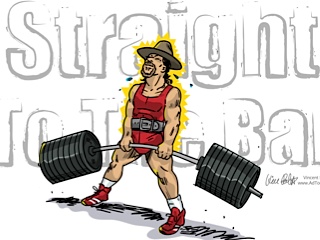This is part two of two of an article on Heavy sandbag training. In part one I covered specifics of building sandbags but did not talk about training. That is what this, the second part, is for. This article is based on my personal experience with sandbags and I will share with you any mistakes I made in the hope you can avoid the same. This article is geared toward someone who is new to sandbag training and who wants to work with weights from 100lbs and up. For people working with lighter weights, the tips on building sandbags may be helpful but you will find more at any of the online sandbag retailers.
This is the year of the sandbag: folks are talking about them, coaches are drilling them, even big budget films are shaping up their extras with this unorthodox training method. Now it’s your turn.
Now you have sandbags. But they don’t do you any good until you train:
- Deadlift
- Clean and Press/Jerk
- Snatch
- Walks/Carries
- Bear hug
- Back
- Side
- Front
- Overhead
The basic concept of a sandbag is to pick it up, so that is where you start. Lay the bag on the ground and pick it up. You will find this an interesting challenge as your first time lifting a sandbag. In this simple lift there are unending variations. First, how you chose to build your bag is a major factor, the looseness of the sand plays a major role. You also have a variety of ways to set the sandbag on the ground. If it is on its end, it is an easier lift, more like a stone. You get your hands under it and lift. To make it more challenging, lay it on its side, running between your legs, lengthwise. Add further to the challenge by turning the bag so it runs lengthwise in front of you. The last one is typically the most challenging and the way that you will do most of your stationary lifts. These lifts also serve as a good introduction to roundback deadlifting. It’s not a topic I will go into but you will find with sandbags and other odd object lifts, that your back has to round some, you cannot maintain the flat olympic back.
The sandbag deadlift naturally progresses into the clean and jerk, which I think is the favored sandbag exercises. It seems to be one of the major sources of hits to my website. A sandbag clean and jerk is more like lifting a log or Atlas stone than a clean and jerk. Typically you start by deadlifting it to your lap. Few people can or will clean a sandbag to something representing the rack position. From the lap, you typically have to change hand position. Most individuals deadlift overhand or will go wide to the ends of the bag, to clean you need to hook your arms under the bag like a Zerher squat. From there you stand up with the bag to a front squat type position. At this point you are almost ready to press or jerk. If you want to go with a real olympic jerk go ahead and do but you’ll find the catch very difficult. You almost always have to half jerk it and get your hands under it then move the weight to the lock-out position. It sounds simple but confusing because there are no rules. You do what you need to do to move the weight each time you lift it, thus it is hard to make sandbag lifting purely technical. A person could work the clean until it was a well-rehearsed movement but it seems like a waste of the unpredictability of the lift. Your further clarification, watch the video:
The walk or carry is my favorite type of sandbag exercise. This is where you support the weight in some way and you carry it, I like to go around a marked soccer field but any distance will do. For a carry, I typically worked with 100lbs at first and moved up to 200 eventually. Each hold makes the challenge level vary greatly. Experimentation is the only way you can learn how the holds work for you, start light.
I think my favorite carry is the bear hug. For this carry I like to start the weight on its end and lift it like a stone. I allow myself to reset my hands while the weight is in my lap and then I start to move. The basic position you want to carry from is to simply wrap your arms around it and squeeze. You can cheat a little by wrapping your arms in such a way that your hands end up at the base of the bag and you slide your hands under the bag to support some of the weight. Depending on your bag it may flop over your arms, this will make it much easier to carry, so you have to decide if that is something you want. My least favorite carry was the back carry. You can go very heavy on this carry but I’m not convinced of the value and I believe there is a huge opportunity for injury here if you get carried away. You basically clean and press the bag overhead then drop it to your shoulders and walk with it. You can do this with more weight if you can find a platform that you can set the bag on and load it to your back from the platform.
A carry that I found valuable but would caution anyone on is the side carry. For this carry you throw the bag on one shoulder with the ends of the bag in front and behind you. You have to go light to begin with on this lift–very few people have the obliques and other supporting muscles to chuck 200lbs on one shoulder and walk with it. I also trained the front carry a fair bit. It’s like the front squat only you’re walking not squatting. This is safer than the last lift and provides good training. Just like you can walk in the front squat position, you can also walk in the overhead squat position. You won’t be able to use much weight but I think you will feel the exercise quickly.
You now have everything you could need to begin sandbag training. This guide is by no means all there is out there. It is written based on my experience training with sandbags. I would invite you all to follow along and learn the lessons as I learn them, more than that I strongly recommend that you go out and do it yourself. It’s one thing to “know” how and what to do, it’s another to have done it.










0 Comments